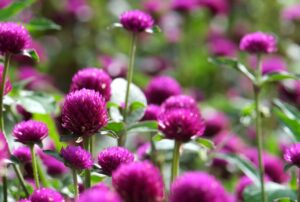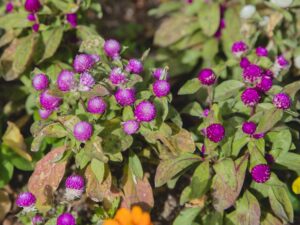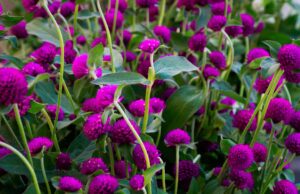Gomphrena flower, commonly known as globe amaranth or bachelor’s button, is a charming flowering plant appreciated for its unique, globe-shaped blooms and long-lasting ornamental value. Belonging to the Amaranthaceae family, Gomphrena encompasses several species, with Gomphrena globosa being one of the most cultivated for its vibrant, papery flowers. Native to Central America and parts of South America, Gomphrena has gained popularity worldwide for its versatility in gardens, landscapes, and floral arrangements.

The distinctive feature of Gomphrena is its spherical flower heads, resembling small, bright-colored globes. These flowers are tightly packed and retain their shape even after drying. Gomphrena flowers come in a range of captivating colors, including shades of purple, pink, white, and red. This diversity makes them a favorite choice for adding a pop of color to gardens and floral displays. One of the notable characteristics of Gomphrena is the longevity of its blooms. The flowers hold their color and form well, both on the plant and as dried flowers, making them suitable for arrangements and crafts.
The plant is adorned with simple, lance-shaped leaves that complement the vibrant flowers. The foliage is typically green, providing an appealing backdrop to the colorful blooms. Gomphrena plants exhibit a compact and bushy growth habit, making them well-suited for borders, edging, and container gardening. They also blend seamlessly into mixed flowerbeds.
In various cultures, Gomphrena holds symbolic significance. It is sometimes associated with immortality, endurance, and everlasting love, making it a popular choice for bouquets and arrangements for special occasions.
Cultivars of Gomphrena Flower
There are several cultivars and varieties of Gomphrena (Gomphrena globosa) available, each offering unique colors and characteristics. Here are some popular cultivars of Gomphrena flower:
‘Fireworks’ Gomphrena: This cultivar features vibrant, exploding blooms in shades of magenta and purple. The flower heads have a distinctive shape, resembling bursts of fireworks, hence the name.
‘QIS’ Series: The ‘QIS’ series includes a range of colors, such as pink, purple, white, and orange. These cultivars are known for their uniform and compact growth habit, making them suitable for containers and borders.
‘Audray’ Series: The ‘Audray’ series offers a mix of colors, including rose, white, and purple. It is prized for its excellent branching and uniformity, providing a neat and tidy appearance in garden settings.

‘Strawberry Fields’ Gomphrena: ‘Strawberry Fields’ produces bright red or strawberry-pink flower heads. The blooms are long-lasting and maintain their color well, making them suitable for both fresh and dried arrangements.
‘Gnome’ Series: The ‘Gnome’ series is known for its dwarf and compact growth, making it ideal for edging, borders, or container gardening. Colors in this series include pink, purple, and white.
‘Lollipop’ Gomphrena: ‘Lollipop’ features rounded flower heads in shades of purple. The compact and bushy plant is well-suited for small gardens, containers, or as an edging plant.
‘Ping Pong’ Gomphrena: This cultivar produces small, globe-shaped flowers in a mix of colors, including pink, purple, and white. The blooms are reminiscent of ping pong balls, giving the plant its name.
‘Buddy’ Series: The ‘Buddy’ series offers a range of colors, and its compact size makes it suitable for small garden spaces or container planting. It includes shades like pink, purple, and white.

‘Haageana’ Species: Gomphrena haageana, commonly known as Mexican Globe Amaranth, has various cultivars with orange, red, or yellow flower heads. It adds warmth and vibrant color to gardens.
‘All Around Purple’ Gomphrena: This cultivar showcases deep purple flower heads and is valued for its heat tolerance and continuous blooming throughout the growing season.
When choosing a Gomphrena cultivar, consider factors such as the desired height, color preferences, and the intended use in your garden or landscape. Whether you opt for the compact ‘Gnome’ series, the vibrant ‘Fireworks,’ or any other cultivar, Gomphrena is sure to add a delightful burst of color to your outdoor spaces.
Sunlight Requirement
Gomphrena plants prefer full sun exposure, which means they should receive at least 6 to 8 hours of direct sunlight daily. Full sun exposure helps the plant produce sturdy stems and vibrant, long-lasting flowers. While Gomphrena prefers full sun, it can tolerate some light afternoon shade, especially in extremely hot climates. However, blooming may be more prolific with ample sunlight.

If growing Gomphrena in containers, place the containers in a sunny location, such as a south-facing patio or balcony. Ensure that the pots have drainage holes to prevent water accumulation.
Temperature and Humidity Requirements of Gomphrena Flower
Gomphrena flowers thrive in warm to hot temperatures, making them well-suited for tropical and subtropical climates. The ideal temperature range for growing Gomphrena is between 70°F to 100°F (21°C to 38°C). They are generally tolerant of high temperatures and can withstand heat well. It is often grown as an annual in cooler climates but can be perennial in regions with mild winters. Gomphrena is adaptable to a range of humidity levels but generally prefers moderate to low humidity.
Soil Requirements
Gomphrena adapts well to various soil types but thrives in moderately fertile, sandy loam or loamy soils. These soil types provide a good balance of drainage and nutrient retention. Maintain a slightly acidic to neutral soil pH for optimal growth. A pH range between 6.0 and 7.5 is suitable for Gomphrena.

Gomphrena plants prefer well-drained soil that allows excess water to escape easily. Gomphrena does not thrive in heavy clay soils that retain too much water. Avoid waterlogged conditions, as they can lead to root rot and other issues.
Propagation of Gomphrena Flower
Gomphrena is commonly propagated through seeds. Here are the methods for propagating Gomphrena through seeds.
Sowing Seeds Indoors: Start seeds indoors 6-8 weeks before the last expected frost. Use a seed-starting mix, press seeds lightly into the soil, and keep them consistently moist until germination.
Direct Sowing: Alternatively, seeds can be sown directly into the garden soil after the danger of frost has passed. Space the seeds according to the plant’s mature size.
Gomphrena seeds typically germinate within 7-14 days when provided with warmth and adequate moisture. Maintain a temperature of around 70-75°F (21-24°C) for optimal germination.
Once seedlings have reached a suitable size and all risk of frost has passed, transplant them into the garden or desired containers. Space the plants according to their mature dimensions.

Water Requirements for Gomphrena Flower
Water the plants regularly, especially during dry periods. Aim to keep the soil consistently moist but not waterlogged. When you water, provide enough moisture to reach the root zone. Deep watering encourages the development of a robust root system, helping the plant withstand periods of drought. While Gomphrena prefers consistent moisture, it does have some drought tolerance once established.
Gomphrena plants prefer consistently moist soil. Ensure that the soil has good drainage to prevent waterlogging, as Gomphrena does not tolerate waterlogged conditions. Well-draining soil helps prevent root rot and other moisture-related issues. If growing Gomphrena in containers, check the moisture level in the potting mix regularly. Container plants may require more frequent watering, especially during hot weather.
Fertilizer Requirements for Gomphrena Flower
Gomphrena flowers are relatively low-maintenance, and they don’t have extremely high fertilizer requirements. However, providing some nutrients can enhance their overall growth and flowering. Use a balanced, all-purpose fertilizer with a ratio such as 10-10-10 or 14-14-14. Apply fertilizer in early spring as new growth begins. You can also provide a second application in midsummer to support continued blooming.
Consider using a slow-release granular fertilizer, which releases nutrients gradually over an extended period. This can reduce the need for frequent applications. If growing Gomphrena in containers, use a water-soluble fertilizer and follow the manufacturer’s instructions for dilution and application frequency. Container plants may require more frequent feeding.

Deadheading Gomphrena Flower
Remove spent flowers regularly to encourage continuous blooming. This practice, known as deadheading, redirects the plant’s energy into producing more flowers.
Support for Tall Varieties
If you are growing tall varieties of Gomphrena, provide support with stakes to prevent the plants from bending or flopping over.
Winter Care
In colder climates, Gomphrena is often grown as an annual. If you live in an area with mild winters, Gomphrena may behave as a perennial. Mulch around the base in fall to protect against frost.
Common Problems While Growing Gomphrena Flower
Despite being a relatively hardy and low-maintenance plant, Gomphrena can face certain issues. Here are some common problems and potential solutions for growing Gomphrena flowers:
Pests: Aphids, spider mites, and whiteflies can sometimes infest Gomphrena plants. Monitor plants regularly for pests. Use insecticidal soap or neem oil to control small infestations.
Powdery Mildew: Powdery mildew, a fungal disease, can affect Gomphrena, especially in conditions with poor air circulation. Provide good air circulation, avoid overhead watering, and use fungicides if necessary. Remove and destroy affected plant parts.
Yellowing Leaves: Yellowing leaves may indicate nutrient deficiencies or overwatering. Ensure proper fertilization with a balanced fertilizer. Adjust watering practices and consider soil amendments if nutrient deficiencies are suspected.

Leggy Growth: Gomphrena may become leggy if not receiving enough sunlight. Ensure the plants receive at least 6-8 hours of direct sunlight daily. Prune leggy stems to encourage bushier growth.
Fertilizer Burn: Excessive fertilization can lead to fertilizer burn, causing leaf discoloration or leaf edge browning. Follow recommended fertilizer application rates and avoid over-fertilizing. Water the plants thoroughly after fertilizing to prevent burn.
Deer and Rabbit Damage: Gomphrena may be susceptible to browsing by deer or rabbits. Use protective measures such as fencing or repellents to deter deer and rabbits. Choose plants that are less attractive to these animals.
Regular monitoring, proper cultural practices, and timely intervention can help address and prevent many of these common problems, ensuring the health and vitality of Gomphrena flowers in your garden.
Ornamental Uses of Gomphrena Flower (Gomphrena globosa)
Gomphrena is a versatile and visually appealing flowering plant that serves various ornamental purposes in gardens and landscapes. Here are some ornamental uses of Gomphrena flowers:
Garden Borders: Gomphrena’s vibrant and long-lasting blooms make it an excellent choice for garden borders. Plant them in clusters along the edges of flower beds to add color and interest.

Cut Flower Arrangements: The globe-shaped flowers of Gomphrena have a unique and captivating appearance, making them a popular choice for cut flower arrangements. They can be dried for long-lasting bouquets or used fresh in floral designs.
Dried Flower Crafts: Gomphrena flowers retain their color and shape well when dried. Harvest the flowers at their peak, hang them upside down to dry, and use them in dried flower arrangements, wreaths, or crafts.
Butterfly and Pollinator Gardens: Gomphrena’s nectar-rich blooms attract butterflies, bees, and other pollinators. Planting Gomphrena in pollinator gardens helps support local ecosystems and adds beauty to the landscape.

Mass Plantings: Create visually striking displays by mass planting Gomphrena in large groups. The compact, bushy habit of the plant ensures a dense and colorful carpet of flowers.

Rock Gardens: Gomphrena’s tolerance for well-drained soil makes it suitable for rock gardens. Plant them among rocks or in dry, sunny areas to add color and texture to the landscape.
Edging Pathways: Use Gomphrena to edge pathways or walkways in your garden. The low-growing varieties provide a neat and colorful border, enhancing the overall aesthetics.
Mixed Plantings: Combine Gomphrena with other annuals or perennials in mixed plantings to create dynamic and diverse flowerbeds. Its compact size allows it to blend well with various garden companions.

Colorful Landscapes: Gomphrena comes in a range of colors, including shades of pink, purple, red, and white. Use different varieties to create vibrant and visually appealing landscapes.
Drought-Tolerant Gardens: Gomphrena’s ability to thrive in hot and dry conditions makes it a valuable addition to drought-tolerant or xeriscape gardens. It adds color while conserving water.

Gomphrena’s captivating appearance, adaptability, and versatility in both fresh and dried arrangements contribute to its widespread use in gardens and floral design. Whether used as a border plant, a component of mixed beds, or as dried flowers in crafts, Gomphrena continues to enchant gardeners and flower enthusiasts alike.


